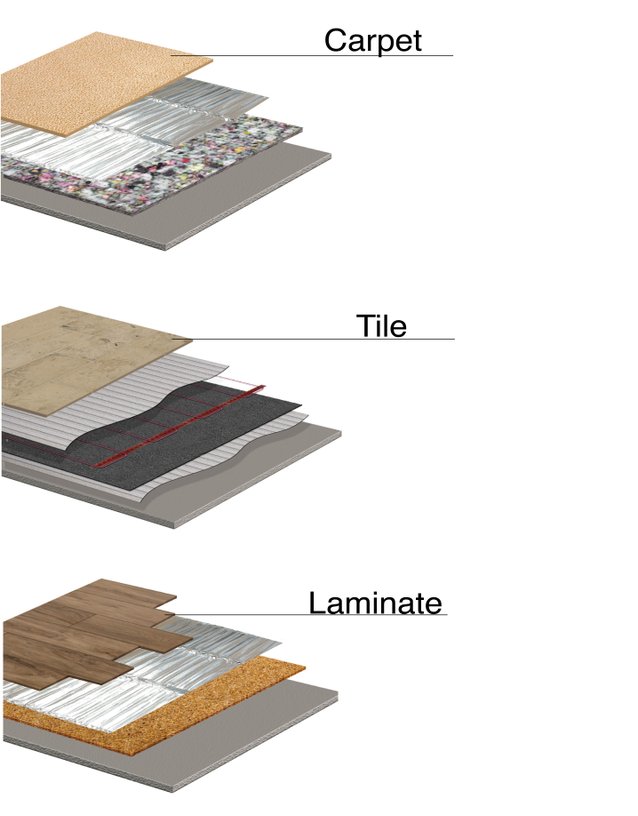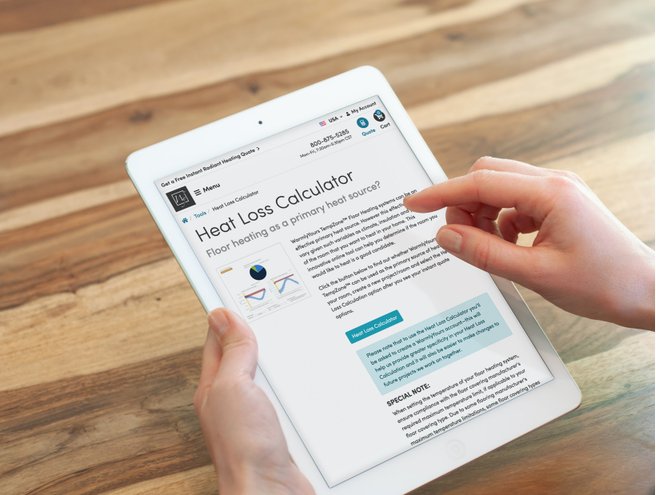
In This Article
As homeowners begin planning remodeling projects, one question that often comes up is whether electric in-floor heating systems can be used as an effective primary heat source for a room or a home — especially when they find out about the affordability of radiant heat.
Can radiant floor heating heat an entire house? We're happy to say that it absolutely can, in the right scenario, which is an exciting prospect, especially considering radiant heat's benefits of no air blowing (which reduces indoor allergies) and soothing whole-room comfort (no cold air pockets in your room).
"When you install radiant heat in your floor, the warm floor can act as a large heating surface, radiating heat into the whole room from the floor up"
And one of the best things is that the installation cost for a radiant heating system will typically be less than the duct-work required to add on to an existing central air system.
"Instead of overheating the room's perimeter in the hopes that the warm air will travel throughout the space before rising, subfloor heating serves up heat from below," explains This Old House's Joe Provey in a BobVila.com article. This results in the entire room, including furniture and objects, being warmer with radiant heat.
However, to determine if this chain reaction will effectively heat the room as a primary heating source, you must account for at least these primary variables such as 1) climate, 2) insulation, 3) position of the room(s) in the home, 4) whether cement slabs or crawl spaces are present under the room, and 5) whether the type of flooring you'd like to use in the room is compatible with the requirements of radiant heat. These variables and more will collectively determine radiant heat's potential effectiveness in the room.
1. How to heat a room in winter?

The colder the climate you live in, the more airtight your room will need to be in order to use radiant heat as a primary heat source. How cold does it get during winter? The colder it gets outside, the more perfectly all the other variables will have to be achieved (tight rooms with minimal heat loss and quality insulation, etc.) in order to create and maintain the level of heat needed cost effectively. A WarmlyYours Heat Loss Calculation is always based on the coldest month of the year, to ensure that room will stay warm even during these few bone-chilling days in the winter.
2. Why insulation is important?
The insulation quality of the room(s) will play a major role in the successful use of radiant heat as a primary heating source. Some rooms will have very poor insulation overall — and this doesn't just include the insulation behind the walls. It includes how well windows and doors are sealed, how many windows there are, the number of doors or fireplaces, etc. For instance, sunrooms often have large windows, very thin walls and a lot of heat loss. In these types of rooms, electric floor heating may not provide quite enough heating capacity to keep that room at a comfortable 70 or 75 degrees, even when insulation is installed. Consider the sum of all the areas of insulation in a room. If the heating capacity is just slightly lower than the heat loss, then a WarmlyYours radiant floor heating system can usually be the primary heat source for three seasons of the year. However, additional heating sources, like a radiant panel or a portable heater, may be needed to keep the room at the desired temperature during the coldest days of winter.
3. Room(s) Position in the Home
Is the room on the interior of the home without any exterior walls to the outdoors? This will affect how much heat you need to produce and how much heat loss will occur. Typically a small area in the interior of the home, like a bathroom, can be easily heated with just floor heating. Also, you need to ask if the room is located over a cement slab or a crawl space? These typically get very cold, and will absorb most of the heat. The floor will not get very warm unless special considerations are made, including the type of insulation used. We recommend you add a layer of insulating underlayment (a type of insulation) under the floor. Learn why in this video. It will dramatically increase the energy efficiency of your electric floor-heating system, and the floor will get a lot warmer.
4. What is the best flooring to use with radiant heat?

The type of flooring you wish to install in a room will impact the temperature that you can set the radiant heat to and how often you need to have it running. When setting the temperature of your floor-heating system, you should ensure compliance with the floor covering manufacturer's required maximum temperature limit, if applicable to your floor covering type. Due to some flooring manufacturers' maximum temperature limitations, some floor covering types may not serve as an optimal choice for a primary or sole heating source.
5. Selecting the Right Floor Heating Element
WarmlyYours also offers a variety of floor heating products with different features to ensure that you find the right solution for your project. Here are some of our most popular floor heating elements along with some useful information about each.
Rolls:
These are the most popular electric floor heating elements we sell and for good reason! We offer both an Environ and TempZone Flex Roll. The TempZone Flex Roll consist of a durable heating cable that is attached to a fiberglass mesh. The heating cable is laid out on the roll in a serpentine pattern to ensure even heating. This product is great for square or rectangular room shapes as the heating element is unrolled and then the fiberglass mesh (never the heating cable) is cut so that the roll can be turned to go back the other way. This "cut-and-turn" installation style is very speedy.
Mats:
These products are very similar to rolls in their construction but differ a bit in their purpose and installation methods. Unlike rolls, mats are designed to be placed in high traffic areas so that you can "spot heat" the places where you walk the most without having to install full coverage heating. This is great for cutting down on both material costs and operation costs moving forward.

Cables:
Floor heating cables offer a lot of flexibility for design and are great for rooms that have an irregular shape or several obstacles that will need to be designed around. Electric floor heating cables can be installed with fixing strips or with uncoupling membranes. The fixing strips are a more economical but also more labor intensive option while the uncoupling membrane can provide speedier installation times and other benefits like crack isolation in addition to the uncoupling benefit.
While you are weighing all these considerations, you can take advantage of a convenient online tool from WarmlyYours to quickly determine if the room you want to heat could be effectively heated with radiant heat — the Heat Loss Calculator.

The calculator will provide a custom report that gives you valuable data and recommendations, including the average heat loss (a BTU/hour estimate) versus the BTU available from a WarmlyYours system based on the details of the room, the operating costs of the system, and a recommendation of whether radiant heat can be a primary heat source.
Taking advantage of the room(s) in your house that are viable radiant floor heating candidates is an exciting prospect. Do your research, use the heat loss calculator, and remember that you can also call our technical support staff and we will be happy to do the heat loss calculation and answer any questions for you at no cost. From there, if the room meets the requirements discussed above, get ready to move forward!
Do you use radiant heat as a primary heat source in any rooms in your home? Let us know on our Facebook page, or tweet us at @WarmlyYours.
Sources: http://www.bobvila.com/articles/2161-radiant-floor-heating-101/#.VOVyu_nF8u8
Have Questions About Your Project?
Our team of Radiant Experts is ready to help!
Comments
Stay Updated
Get the latest radiant heating news and tips delivered to your inbox.



I have a second house in Vermont. We turn the heat down when leaving for the mid week and turn it back up on the weekends. Will this be efficient with radiant heat?
Adjusting the temperature of your system to take advantage of the times when you’re not home is a great way to save money and maintain energy efficiency. It's just one of many strategies that programmable thermostats make possible with radiant heating. However, to answer your question about your specific application, we’ll need more detailed information about your home and heating system. Feel free to give us a call at (800) 875-5285. Our Installation Support team is available 24/7 and they’ll be able to answer any questions you might have.
thermostat set to have temp at 72 at 3 o'clock in one zone so does it start before or at 3?
Thanks for reading, Larry. That's a good question. We can really only speak about the thermostats that we sell, but our nSpire Touch (and nSpire Touch WiFi) thermostats have an adaptive function that can be enabled in the "Installer Settings". This means the thermostat, after about a week of operation, will "figure out" how long it takes to get up to the set temperature for the floor the heating system is installed in. So in your example, it might take your floor 30 minutes to get up to 72 degrees, which means the thermostat would turn the system on at 2:30 so it's 72 degrees at 3. Hope that helps.
Would laying new tile over old tile affect the heat from radiant floor?
That's a very interesting question. We recommend that our TempZone electric floor heating elements (the ones that are most commonly installed with tile) are installed no deeper than 1.5" from the finished flooring surface. So, as long as the heating system is no deeper than 1.5" from the finished flooring surface, it's possible that a new layer of tile and adhesive could be installed on top of the existing heated tile floor. You'll want to be careful about this though because of the impact it will have on both floor height and floor weight. Regarding the impact that this method would have the radiant heating: the only real difference you should see is that it takes a bit longer for the system to warm up (as the floor has significantly more mass). After that the warm up, the system should function very similarly to a radiant heating system that is installed in a more traditional manner. If you have any further questions, please don't hesitate to reach out to us at 1-800-875-5285.
When renovating an entire house will a radiant heating system pass inspection if you have no other heating source other than a wood-burning or pellet stove.
We do have several customers who heat their homes using floor heating as a primary heat source but passing inspection will depend largely on your local code (and the amount of BTUs or heat output that they require for a residential property) so we can't really answer that for you. We highly recommend that you speak to a local building inspector as they should be knowledgeable in the specific details in your area. However, you can get a rough estimate of how much heat output (and how much heat loss) your building and radiant heating system would incur by using our Heat Loss Calculator: https://www.warmlyyours.com/floor-heating/heatloss-calculator.
For some reason I have not been able to get to heat loss calculator after creating my account.
Laura, we're so sorry that you had that issue but thank you very much for letting us know. Our IT is looking at it now and we hope to have the issue resolved shortly.
If I have in floor heat in the basement and have a three level house will the basement heat help heat the entire house?
That's a very interesting question but the short answer is no, installing floor heating in your basement won't be an effective way to heat all 3 levels of the home. It'll be a great way to heat your basement (in fact we have a lot of clients who use it for that purpose) but a lot of the heat emanating from the basement system will be absorbed before it can turn the floor of the next level into a radiant source of heat. Your best bet is to install a heating system in each level of the home to help provide the level of comfort you'd expect from radiant heating.